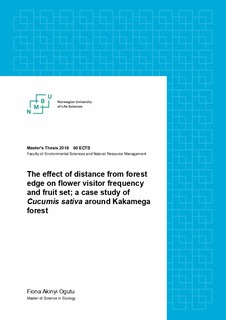| dc.contributor.advisor | Sheil, Douglas | |
| dc.contributor.advisor | Nielsen, Anders | |
| dc.contributor.author | Ogutu, Fiona Akinyi | |
| dc.coverage.spatial | Kenya, Kakamega forest | nb_NO |
| dc.date.accessioned | 2019-04-02T11:58:34Z | |
| dc.date.available | 2019-04-02T11:58:34Z | |
| dc.date.issued | 2018 | |
| dc.identifier.uri | http://hdl.handle.net/11250/2592930 | |
| dc.description.abstract | Pollination is a key ecosystem function that is important for food production. This service is maintained by natural habitats which provide a dwelling place for these pollinators. However, these natural habitats are on the decline due to various human activities such as conversion of forests to arable land.
This study analyzed the frequency of flower visits on cucumber flowers with increasing distance from the forest edge and subsequent pollination success of these plants. The plants were grown in the nursey and transferred to the field at the onset of flowering. Sixteen study sites were located along four 300m transects over 1km apart.
Data was collected through direct observation. Observations were done in the morning from 7.30am and in the afternoon from noon for a five-day period. Each plant was observed for ten minutes and the number of insects landing on its reproductive parts counted. At the end of the five-day observation period, the number of fruits formed were counted.
In total 504 flower visits were observed over the five-day period. Distance had a negative effect on frequency of flower visits; there was a decrease in flower visits with increasing distance from the forest edge. Visits declined by 34% (+-9.4%) with every 100m meter increase in distance from forest edge. However, distance and visitation frequency had no detected effect on fruit set.
This study demonstrates that tropical forest provides a source population for flower visitors and thus the need to conserve them. | nb_NO |
| dc.language.iso | eng | nb_NO |
| dc.publisher | Norwegian University of Life Sciences, Ås | nb_NO |
| dc.rights | Attribution-NonCommercial-NoDerivatives 4.0 Internasjonal | * |
| dc.rights.uri | http://creativecommons.org/licenses/by-nc-nd/4.0/deed.no | * |
| dc.subject | Pollination ecology | nb_NO |
| dc.subject | Kenya | nb_NO |
| dc.subject | Flower visitation frequency | nb_NO |
| dc.title | The effect of distance from forest edge on flower visitor frequency and fruit set : a case study of Cucumis sativa around Kakamega forest | nb_NO |
| dc.type | Master thesis | nb_NO |
| dc.subject.nsi | VDP::Mathematics and natural science: 400 | nb_NO |
| dc.source.pagenumber | 27 | nb_NO |
| dc.description.localcode | M-ECOL | nb_NO |

